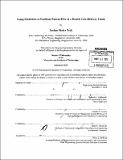Using prediction to facilitate patient flow in a health care delivery chain
Author(s)
Peck, Jordan S. (Jordan Shefer)
DownloadFull printable version (18.19Mb)
Other Contributors
Massachusetts Institute of Technology. Engineering Systems Division.
Advisor
Deborah Nightingale.
Terms of use
Metadata
Show full item recordAbstract
A health care delivery chain is a series of treatment steps through which patients flow. The Emergency Department (ED)/Inpatient Unit (IU) chain is an example chain, common to many hospitals. Recent literature has suggested that predictions of IU admission, when patients enter the ED, could be used to initiate IU bed preparations before the patient has completed emergency treatment and improve flow through the chain. This dissertation explores the merit and implications of this suggestion. Using retrospective data collected at the ED of the Veterans Health Administration Boston Health Care System (VHA BHS), three methods are selected for making admission predictions: expert opinion, naive Bayes conditional probability and linear regression with a logit link function (logit-linear regression). The logit-linear regression is found to perform best. Databases of historic data are collected from four hospitals including VHA BHS. Logit-linear regression prediction models generated for each individual hospital perform well based on multiple measures. The prediction model generated for the VHA BHS hospital continues to perform well when predictive data are collected and coded prospectively by nurses. For two weeks, predictions are made on each patient that enters the VHA BHS ED. This data is then summarized and displayed on the VHA BHS internet homepage. No change was observed in key ED flow measures; however, interviews with hospital staff exposed ways in which the prediction information was valuable: planning individual patient admissions, personal scheduling, resource scheduling, resource alignment, and hospital network coordination. A discrete event simulation of the system shows that if IU staff emphasizes discharge before noon, flow measures improve as compared to a baseline scenario where discharge priority begins at 1pm. Sharing ED crowding or prediction information leads to best patient flow performance when using specific schedules dictating IU response to the information. This dissertation targets the practical and theoretical implications of using prediction to improve flow through the ED/IU health care delivery chain. It is suggested that the results will have impact on many other levels of health care delivery that share the delivery chain structure.
Description
Thesis (Ph. D.)--Massachusetts Institute of Technology, Engineering Systems Division, 2013. Cataloged from PDF version of thesis. Includes bibliographical references (p. 163-178).
Date issued
2013Department
Massachusetts Institute of Technology. Engineering Systems DivisionPublisher
Massachusetts Institute of Technology
Keywords
Engineering Systems Division.